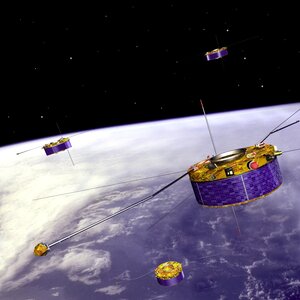Shocking recipe for making killer electrons
Take a bunch of fast-moving electrons, place them in orbit and then hit them with the shock waves from a solar storm. What do you get? Killer electrons. That’s the shocking recipe revealed by ESA’s Cluster mission.
Killer electrons are highly energetic particles trapped in Earth's outer radiation belt, which extends from 12 000 km to 64 000 km above the planet’s surface. During solar storms their number grows at least ten times and they can be dislodged, posing a threat to satellites. As the name suggests, killer electrons are energetic enough to penetrate satellite shielding and cause microscopic lightning strikes. If these electrical discharges take place in vital components, the satellite can be damaged or even rendered inoperable.
On 7 November 2004, the Sun blasted a solar storm in Earth’s direction. It was composed of an interplanetary shock wave followed by a large magnetic cloud. When the shock wave first swept over the ESA-NASA solar watchdog satellite SOHO, the speed of the solar wind (the constant flow of solar particles) suddenly increased from 500 km/s to 700 km/s.

Shortly afterwards, the shock wave hit Earth’s protective magnetic bubble, known as the magnetosphere. The impact induced a wave front propagating inside the magnetosphere at more than 1200 km/s at geostationary orbit (36 000 km altitude) around Earth. The quantity of energetic electrons in the outer radiation belt started to increase too, according to Cluster’s RAPID instruments (Research with Adaptive Particle Imaging Detectors). Cluster’s four satellites sweep around an elliptical orbit, coming as close as 19 000 km and going out as far as 119 000 km.
Understanding the origin of the killer electrons has been a focus for space weather researchers. Thanks to previous data collected by Cluster and other space missions, scientists proposed two methods by which electrons can be accelerated to such harmful energy levels. One relies on very low frequency (VLF) waves of 3–30 kHz, the other on ultra low frequency (ULF) waves of 0.001–1 Hz. This latest work disentangles the problem.
Which waves are responsible? Both of them. “Both VLF and ULF waves accelerate electrons in Earth’s radiation belts, but with different timescales. The ULF waves are much faster than the VLF, due to their much larger amplitudes,” says Qiugang Zong from Peking University (China) and University of Massachusetts Lowell (USA), lead author of the paper describing this result.
The data show that a two-step process causes the substantial rise of killer electrons. The initial acceleration is due to the strong shock-related magnetic field compression. Immediately after the impact of the interplanetary shock, Earth’s magnetic field lines began wobbling at ultra low frequencies. In turn, these ULF waves were found to effectively accelerate the seed electrons provided by the first step, to become killer electrons.
Although the analysis has been a long one, the results have been worth the wait. Now astronomers know how killer electrons are accelerated. “Data from the four Cluster satellites allowed the identification of ULF waves able to accelerate electrons,” says Malcolm Dunlop, Rutherford Appleton Laboratory, Didcot (UK) and co-author of this study.
Thanks to this analysis of Cluster data, if the killer electrons happen to be ejected towards Earth, we now know that they can strike the atmosphere within just 15 minutes. “These new findings help us to improve the models predicting the radiation environment in which satellites and astronauts operate. With solar activity now ramping up, we expect more of these shocks to impact our magnetosphere over the months and years to come,” says Philippe Escoubet, ESA’s Cluster mission manager.
Note to editors
The results are published in Zong, Q.-G., X.-Z. Zhou, Y. F. Wang, X. Li, P. Song, D. N. Baker, T. A. Fritz, P. W. Daly, M. Dunlop, and A. Pedersen (2009), Energetic electron response to ULF waves induced by interplanetary shocks in the outer radiation belt, J. Geophys. Res., 114, A10204, doi:10.1029/2009JA014393.
For more information
Qiugang Zong
Peking University
China and University of Massachusetts
Lowell, USA
Email: qgzong@pku.edu.cn
Arnaud Masson
Science and Robotic Exploration Directorate
ESA
The Netherlands
Email: Arnaud.Masson@esa.int
Phone: +31-71-565-5634















 Germany
Germany
 Austria
Austria
 Belgium
Belgium
 Denmark
Denmark
 Spain
Spain
 Estonia
Estonia
 Finland
Finland
 France
France
 Greece
Greece
 Hungary
Hungary
 Ireland
Ireland
 Italy
Italy
 Luxembourg
Luxembourg
 Norway
Norway
 The Netherlands
The Netherlands
 Poland
Poland
 Portugal
Portugal
 Czechia
Czechia
 Romania
Romania
 United Kingdom
United Kingdom
 Slovenia
Slovenia
 Sweden
Sweden
 Switzerland
Switzerland



























